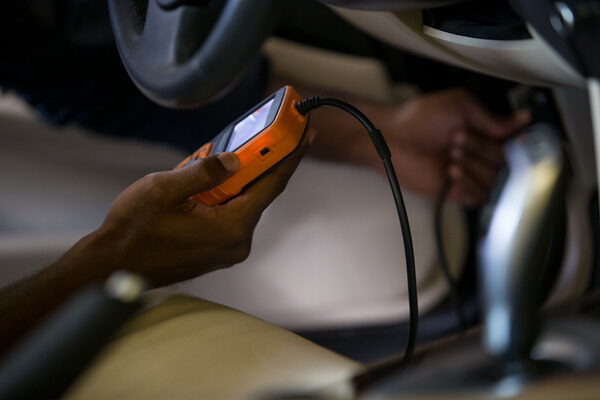
To understand whether you have a bad alternator or a bad battery, you need to understand how a car’s engine starts. Engines start using a cyclical process – the battery sends electricity to the starter, which then starts the engine and turns on the alternator, which then charges the battery so it will last longer and be able to start the engine the next time.
If just one part of the car starting process fails, the cycle cannot complete, and your car won’t start. You can identify which part of the cycle is failing by trying to jump-start your car using jumper cables. You can learn how to jump-start your car here. If your car starts but quickly turns off again, that could mean your alternator is failing to charge your battery. If it starts and remains on, but you’re unable to start it again without the jumper cables, then your battery most likely needs to be replaced.
Alternator or Battery: what’s causing the problem?
What does an alternator do?
Different from the battery, which is essential for starting your car, the alternator powers your car when the engine is up and running. This includes powering headlights, electric steering, power windows, windshield wipers, heated seats, and radio. An alternator typically lasts the entire lifetime of your car, but general wear and tear can damage the alternator, requiring repair or replacement sooner. [1]
Signs of a bad alternator
If the battery is working, it’s time to take a closer look at the alternator. Here’s how to tell whether your alternator is bad: [2]
- Dim interior lights: Feel like your interior lights are underperforming? Dim interior lights are a sign your alternator could be faulty.
- Dim or overly bright headlights: Headlights are not supposed to brighten and dim as you slow and/or accelerate. If you notice yours doing this, the alternator could be failing.
- Growling noises: A growling sound sometimes occurs before an alternator fails.
- Smell of burning rubber or hot wires: One cause of an ailing alternator is overheating, which can produce a burning smell.
- Test the alternator: Testing your alternator can provide a clear answer, but be careful about how you do it. Find out how to test an alternator.
How to replace an alternator
If you want to fix your alternator, you can take it to a repair shop or easily fix it yourself. All you’ll need is a serpentine belt diagram to help you put the belt back on in the right place. To do this repair, disconnect the battery, remove the serpentine belt, unbolt the alternator, and remove the wiring connectors. To install the new alternator, just reverse those steps. If you aren’t comfortable and experienced working on cars, it may be best to have a pro replace the alternator for you. [3]
What does a car battery do?
There are 5 main functions that a battery does for your car. The car battery:
- Stores power for your car.
- Provides energy to start the engine.
- Delivers electricity to the ignition system.
- Works with the alternator to power electronics.
- Helps regulate voltage. [4]
Signs of a bad battery
Check for these common symptoms of a dead battery:
- Dim dashboard lights: If you’re squinting to read your dashboard, that’s a sign your battery is dead or dying. Try testing these lights by turning your key enough to engage the battery, but not turn over the engine. Since the battery should supply power to these lights even when the engine is off, failure to light up properly is an indication of battery issues.
- Battery corrosion: Sometimes, batteries leave clear, visible dysfunction indications. Check yours for corrosion, and if you find any, use a rag or a wire brush to remove the corrosion. Then, give your car a jumpstart to determine if this corrosion was the issue. If your car remains running after the jumpstart, but you can’t get it to turn back on without jumper cables, that’s an indication that your alternator is working fine, but your battery is failing to maintain a charge.
- Old car battery: Car batteries are powerful, but they don’t last forever. Most batteries will keep your car running for 3-5 years, but after that time they begin to have trouble holding charge. [5] You can take steps to lengthen your battery’s lifespan, but at a certain point it will be unable to hold enough charge to start your engine.
- Radio won’t turn on: If your ignition is in the on position, the battery should be able to run your radio, headlights, windshield wipers, and other electronic components. If you notice your radio display or headlights flickering or dimming, there’s a possibility your battery isn’t well-charged.
- Car starts and dies immediately: This can happen for a number of reasons, but checking your battery is a good place to start troubleshooting. This is an odd problem that typically happens only on certain vehicles, and it’s a result of the battery having only enough voltage to start the car.
- Swollen battery: If your battery is bloated, you should be able to notice it thanks to the manufacturer’s design. You’ll easily be able to identify bulging in the battery’s casing. This problem occurs when your alternator has overcharged the battery due to a bad voltage regulator.
Having a failing alternator or battery can be a nuisance, especially if you’re on the road. Make sure you have roadside assistance so you can get help if your car doesn’t start. Also, protect yourself and your car while on the road with auto insurance.
Sources:
[1] “What Is A Car Alternator, And How Does It Work?” firestonecompleteautocare.com/blog/maintenance/what-does-an-alternator-do/ (Accessed April 2024).
[2] “Car battery dead? 8 signs of a dead car battery,” autozone.com/diy/battery/is-your-car-battery-dead (Accessed April 2024).
[3] “Alternator Problems and Repair,” myautorepairadvice.com/alternator_problems.html (Accessed April 2024).
[4] “The 5 Functions of a Car Battery,” mach1services.com/functions-of-a-car-battery (Accessed April 2024).
[5] “How Long Do Car Batteries Last?” aaa.com/autorepair/articles/how-long-do-car-batteries-last (Accessed April 2024).
Disclaimer:
The information included here is designed for informational purposes only. It is not legal, tax, financial or any other sort of advice, nor is it a substitute for such advice. The information may not apply to your specific situation. We have tried to make sure the information is accurate, but it could be outdated or even inaccurate in parts. It is the reader’s responsibility to comply with any applicable local, state or federal regulations. Nationwide Mutual Insurance Company, its affiliates and their employees make no warranties about the information nor guarantee of results, and they assume no liability in connection with the information provided. Nationwide and the Nationwide N and Eagle are service marks of Nationwide Mutual Insurance Company. © 2024 Nationwide



